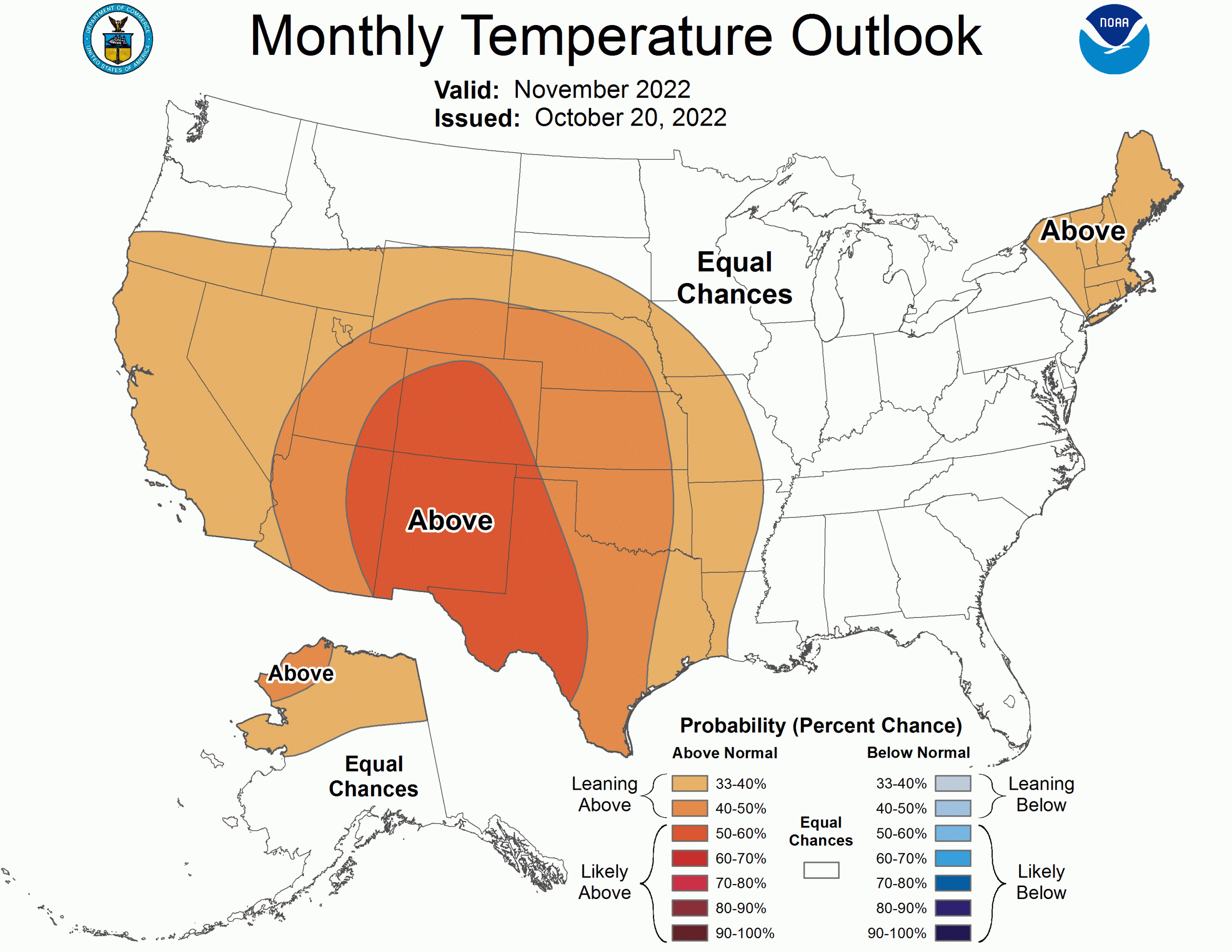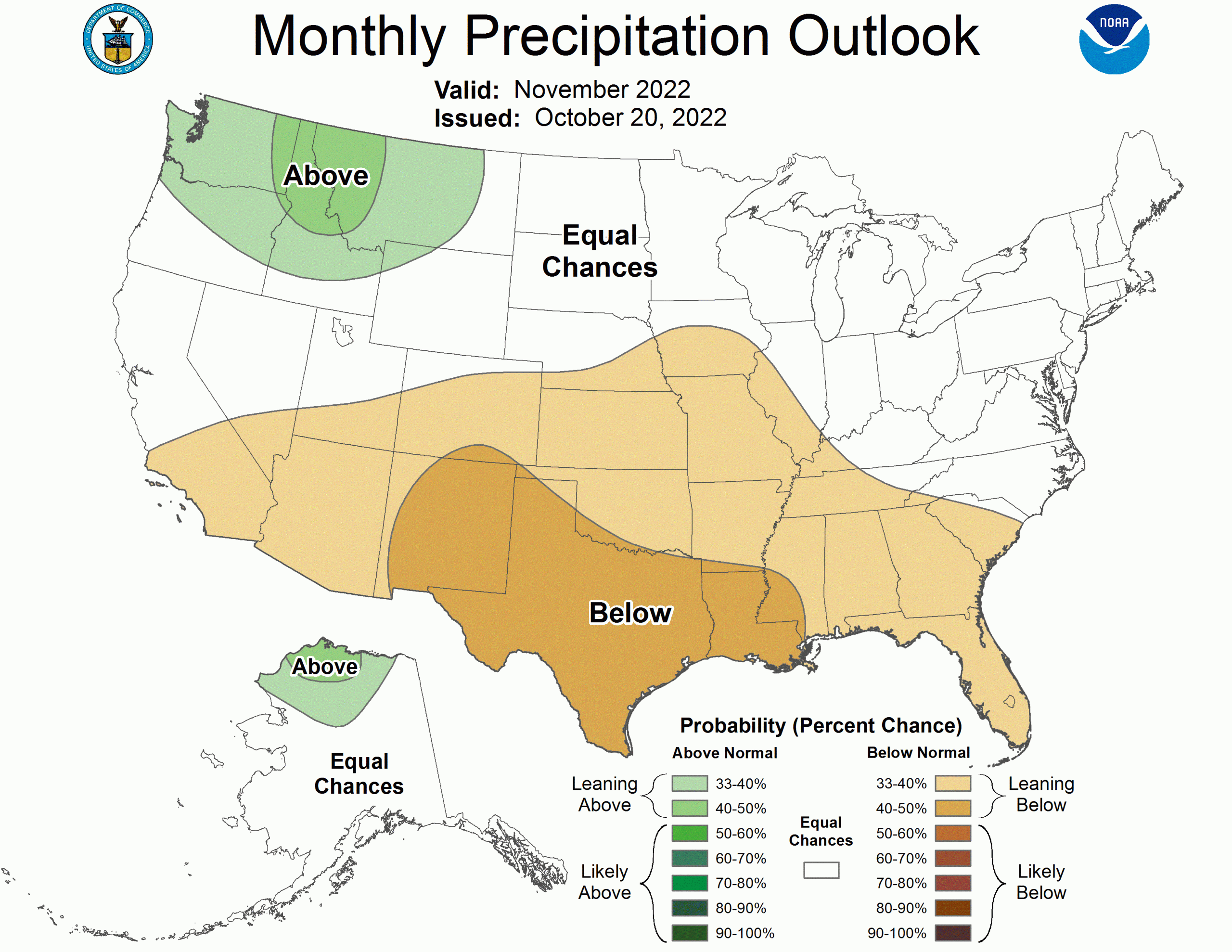
The NOAA just released its outlook for November 2022. As the month when the majority of ski resorts begin opening, we’re hoping for cold and snowy to kick off the season right.
Expect above-normal temperatures for the majority of the west and the northeast, and with the exception of the northwest, expect normal or below-normal precipitation.
The full discussion is below:
30-DAY OUTLOOK DISCUSSION FOR NOVEMBER 2022 The November 2022 Temperature and Precipitation Outlooks are prepared against a backdrop of established La Niña conditions in the Tropical Pacific, and include the latest statistical and dynamical model guidance, impacts from decadal trends, and local sea surface temperature (SST) anomalies. The latest NINO3.4 weekly SST departures reached -0.8 degrees Celsius and the tropical Pacific atmosphere remains consistent with La Niña. Following a progressive Madden Julian Oscillation (MJO) pattern in both observations and forecasted Realtime Multivariate MJO (RMM) indices, recent RMM forecasts from the Global Ensemble Forecast System (GEFS) and European Centre for Medium-Range Weather Forecasts (ECMWF) models indicate a stagnanting MJO signal. MJO did not play a significant role in the November 2022 Outlooks. Dynamical model guidance from the North American Multi-Model Ensemble (NMME), Copernicus model suite (C3S), and dynamical model predictions from the Climate Forecast System version 2 (CFSv2) were considered for the outlook, as well as statistical models that include the influence of La Niña and trend on temperature and precipitation. Week 3-4 forecasts from CFSv2 and GEFSv12 for the early part of November were also considered. Week-2 dynamical model guidance favors troughing over the Western US, which is expected to shift eastward by the Week 3-4 period (early November). By the Week 3-4 period, GEFSv12 and CFSv2 are in agreement on western U.S. ridging, while the strength, location, and timing of predicted troughing over the eastern U.S. is uncertain. Recent monthly CFSv2 temperature forecasts favor above normal probabilities over the western U.S. with weaker probabilities over the eastern U.S., likely related to the forecasted ridge and trough pattern. Though there is good agreement among tools on above normal temperature probabilities over much of the western and south-central U.S., monthly forecasts of temperature from NMME and C3S favor weaker, but still above normal temperature probabilities over the eastern U.S. A consolidation of statistical tools indicates equal chances of above, normal, or below normal temperatures (EC) from the eastern part of Texas to the east coast, with increased odds of above normal temperatures in the western U.S. Given the agreement among tools on probability of above normal temperatures over the western U.S. along with forecasted ridging, above normal temperature probabilities are indicated for much of the western 2/3 of the CONUS. The area of highest probabilities over the Southwest and parts of Texas is consistent with the region of strongest dynamical and statistical model agreement. A weak tilt toward above normal temperatures is favored over parts of New England owing to decadal trends as well as consistency between NMME and C3S, however, coastal SSTA are cool or mixed which led to a dampening of the probabilities. In contrast, uncertainty in the strength, position, and timing of the forecasted troughing during the early part of November, along with weak signals from NMME, C3S, and statistical guidance led to EC over the Great Lakes, Mid-Atlantic, and Southeast. There is some indication of weak odds of below normal temperatures over the Pacific Northwest when considering a statistical tool of constructed analogues of NINO3.4 SSTA, however, this signal is not consistent in NMME, C3S, or other available statistical tools, thus, EC is also favored for the Pacific Northwest and northern parts of CONUS. Temperature forecasts over Alaska are mixed, with GEFS and CFSv2 disagreeing on the strength and positioning of troughing or ridging over Alaska in early parts of November, and much of Alaska tilting toward EC in monthly statistical and dynamical tools. The area of best agreement is along the North Slope of Alaska where trends and expected La Niña impacts tilt toward above normal temperatures. This is further supported by warmer than normal SSTs and below normal sea ice off the north coast of Alaska. As such, EC is favored for much of southern Alaska in the November Outlook, with a small area of above normal temperatures favored over the North Slope. A generally dry pattern is favored by dynamical and statistical models over much of the southern half of the U.S. Recent CFSv2 predictions favor an overall dry pattern over most of CONUS, with some weakness in the western U.S. and a tilt toward above normal precipitation in the Pacific Northwest. The dry southern tier of CONUS is consistent with expected La Niña impacts. The area of strongest statistical and dynamical model agreement on below normal precipitation is from the region stretching from Arizona across Texas, and probabilities are enhanced accordingly. A tilt toward above normal precipitation is indicated over the Pacific Northwest, consistent with expected impacts from La Niña and dynamical model guidance from NMME and C3S. EC is indicated for the northern Great Plains to the Northeast given weak or inconsistent signals from statistical and dynamical model guidance. Elevated probabilities of above normal precipitation are favored for the North Slope of Alaska given expected impacts from La Niña and decadal trends . EC is favored for the remainder of Alaska given uncertainty amongst tools. FORECASTER: Johnna Infanti
